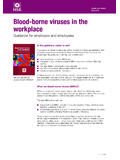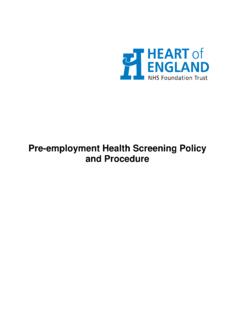Transcription of Infection at work: Controlling the risks - hse.gov.uk
1 Advisory Committee on Dangerous Pathogens Infection at work: Controlling the risks A guide for employers and the self employed on identifying, assessing and Controlling the risks of Infection in the workplace .. Crown copyright 2003. Applications for reproduction should be made to: Copyright Unit, Her Majesty's Stationery Office, St Clements House, 2-16 Colegate, Norwich NR3 1BQ. First published 2003. All rights reserved. No part of this publication may be reproduced, stored in a retrieval system, or transmitted in any form or by any means (electronic, mechanical, photocopying, recording or otherwise) without the prior written permission of the copyright owner. This guidance is prepared in consultation with the Health and Safety Executive, by the Advisory Committee on Dangerous Pathogens, which was appointed by the Health and Safety Commission as part of its formal advisory structure and by Health Ministers.
2 The guidance represents what is considered to be good practice by members of the Committee. It has been agreed by the Commission and Health Ministers. Following the guidance is not compulsory and you are free to take other action but if you do follow it you will normally be doing enough to comply with the law. Health and safety inspectors seek to secure compliance with the law and may refer to this guidance as illustrating good practice.. Page ii Advisory Committee on Dangerous Pathogens .. Contents What is the guide about? 1. What do I have to do? 2. Identifying the hazard 3. Chain of Infection 3. Sources 3. Transmission 4. Host 4. Assessing the risk 5. Controlling the risk 10. Appendix 1: Risk assessment form and examples 14. Appendix 2: Common occupational infections 19. Appendix 3: Further reading and information 24.. age iii P Advisory Committee on Dangerous Pathogens.
3 WHAT IS THIS GUIDE ABOUT? Hint 1. Hint 1. You should make sure your 1 This guide deals with the risk of assessment identifies work Infection at work, but it is not aimed at activities where: those who deliberately work with micro-organisms, eg in laboratories. workers may be at You should use this guidance if your greater risk, eg pregnant employees or those employees could come into contact whose immune system is with infectious micro-organisms as a not functioning properly, result of the kind of work they do, eg: eg because they are undergoing medical working with animals (eg treatment or are already farming); suffering from an Infection ;. working with people who might be infectious (eg patients in workers and other people hospitals); who may not be in the workplace all the time, handling waste material that may eg cleaners, maintenance be contaminated with micro- and repair workers, organisms (eg refuse disposal); students on placements.
4 And working in an environment or with equipment (eg sewer members of the public maintenance) that could be who might be present, contaminated. eg visitors to open farms, if there is a chance that Did you know? they could be exposed to Infection as a result of There were nearly 700 new Did you know? your work. cases of occupationally- acquired Infection in 2001. We know this is a 2 This guide addresses your considerable underestimate duties under The Control of because most infections will Substances Hazardous to Health only be reported if they Regulations 2002 (COSHH). You require medical attention - may already know that these many infections are mild and regulations deal with the control of people get better without any chemicals in the workplace, but they need for medical treatment. also cover infectious micro-organisms. But, they may still cause long- term effects and the risks from such infections need to be controlled in the same way as more serious infections.
5 Age 1. P Advisory Committee on Dangerous Pathogens .. WHAT DO I HAVE TO DO? assessment yourself but, if not, you should call on help and advice from 3 You can deal with the risks from within your own organisation, or if this Infection at work in the same way as is not available, from outside sources, any other health and safety issue. eg consultancies. You need to: 8 If you employ more than five identify the hazards; people you must write down the significant findings of your assess the risks ;. assessment. You should record the control the risks . significant hazards identified in your assessment, and the controls that are 4 As well as considering the risks in place or are to be used (see to your employees, you also need to Appendix 1). If you have fewer than decide whether the work that you do five employees, you do not need to puts others at risk of Infection .
6 For write anything down, but you may find example you may run a farm that is it useful to keep a written record of also open to the public. You have a what you have done. duty under health and safety law to protect your visitors too (see Hint 1). 9 Your risk assessment is a living document and should reflect any 5 Although some jobs involve changes in the work that you do, new dealing with lots of people, eg driving equipment that is used or a new work a bus, the risk of Infection in the activity is added if this changes the course of such work is likely to be no risk or leads to new hazards being greater than that of, say, the introduced. It is also good practice passenger who uses the bus every to review your assessment from time day. The risk of Infection has to be to time to make sure that the controls foreseeable before you need to carry you are using are working and still out an assessment and take appropriate.
7 Measures to control the risks . For example someone who cleans buses 10 If any of your employees catch in certain areas may be at risk from an Infection as a result of their work, contact with dirty needles and other these must be reported to HSE under rubbish. They need to be protected the Reporting of Injuries, Diseases during the course of their work. and Dangerous Occurrences Regulations 1995. 6 Although your employees may well pick up infections from Note: This guide uses the term workmates (just as they might from infectious micro-organisms' but their friends and family outside work) you should note that health and these infections are not your safety law uses the term responsibility under health and safety biological agents'. By infectious law. This is because the Infection is micro-organisms/biological agents just as likely to be caught outside the we mean the bacteria, viruses, workplace as in it.
8 But there may be fungi and internal parasites (such other laws which require you to take as tapeworms) that create a action (see Hint 2). hazard to human health. Most harm you by Infection but they can 7 Carrying out a risk assessment also cause allergies or be toxic. is your responsibility as the employer. You may be able to carry out the .. Page 2 Advisory Committee on Dangerous Pathogens .. 11 Further information about risk 13 However, certain micro- assessment, as well as information organisms can cause disease and about infections and controls for your employees may be exposed to certain occupations, is given in them at work. Appendix 3. 14 Further detail about sources Hint 2 and the process of Infection is given in There are other regulations the following section The chain of Hint 2. (not health and safety at work Infection '. regulations) that deal with risks from micro-organisms 15 The good news is that that you may also need to Controlling the risk of Infection is consider, on: relatively straightforward usually, simple good personal hygiene food safety; measures, such as washing hands, are sufficient.
9 Environmental protection; and Chain of Infection public health. 16 The process of Infection can be represented as a chain - breaking a IDENTIFYING THE HAZARD link in the chain at any point will control the risk of Infection . When you 12 Micro-organisms are found identify the hazard, you need to find virtually everywhere in the natural out about the links in the chain to help environment. Most of these are you identify the best way to break it harmless to humans and do many and so control the risk. important jobs. They are used to make medicine. They can break down Transmission the oil from oil spills. They make about half of the oxygen we breathe. Did you know? Host Bacteria live on or in just Source Did you know? about every material and environment, from soil to Sources water to air, and from the deep ocean to Arctic ice to 17 There are four main sources of volcanic vents.
10 There are Infection that you need to consider in more bacterial cells in the a workplace: human body than there are human cells, and some are blood and other body fluids (eg saliva) and sources of absolutely necessary to our blood/body fluids such as human survival. On each square bodies, animal carcases and raw centimetre of our skin there meat;. are about 100 000 bacteria and a single teaspoon of human or animal waste products topsoil contains more than a such as faeces, urine and vomit;. billion bacteria. respiratory discharges such as coughs and sneezes; and skin direct contact.. age 3. P Advisory Committee on Dangerous Pathogens .. 18 Outside work, people can also Host become infected if they eat and drink contaminated food and water or 22 Unbroken skin and the lining of BREAKING THE CHAIN. through sexual intercourse, but these the mouth, throat, gut and airways all routes are not covered in this guide.











